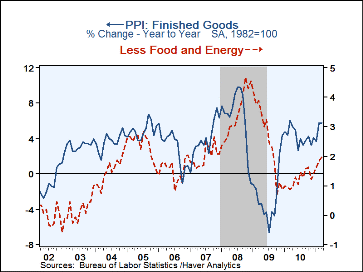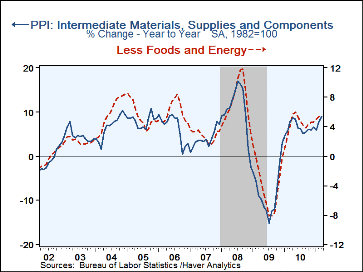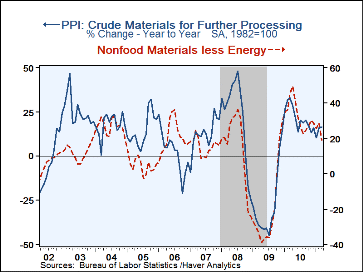 Global| Apr 14 2011
Global| Apr 14 2011U.S. PPI Increase Moderates
by:Tom Moeller
|in:Economy in Brief
Summary
The U.S. Producer Price Index for finished goods increased 0.7% last month after the 1.6% jump during February. The March increase was less than the 1.0% Consensus expectation. Less food & energy, however, pricing pressures picked up [...]
 The U.S. Producer Price Index for finished goods increased 0.7%
last month after the 1.6% jump during February. The March increase was
less than the 1.0% Consensus expectation. Less food & energy, however,
pricing pressures picked up slightly. The 0.3% gain in the PPI less food
& energy was up from 0.2% in February. It exceeded Consensus expectations
for a 0.2% rise and raised the y/y gain to 2.0%, its highest since summer
2009.
The U.S. Producer Price Index for finished goods increased 0.7%
last month after the 1.6% jump during February. The March increase was
less than the 1.0% Consensus expectation. Less food & energy, however,
pricing pressures picked up slightly. The 0.3% gain in the PPI less food
& energy was up from 0.2% in February. It exceeded Consensus expectations
for a 0.2% rise and raised the y/y gain to 2.0%, its highest since summer
2009.
Energy prices again were strong and posted a 2.6% increase (17.4% y/y) as gasoline prices increased a not seasonally adjusted 14.2% (31.2% y/y). Since the late-2008 low, gasoline prices have more-than-doubled. Home heating oil prices also were strong, posting a 8.4% (39.2% y/y) increase. Natural gas prices fell 2.7% (-2.9% y/y) while electricity prices slipped 0.1% (+3.3% y/y). Food prices backpedaled 0.2% (+4.5% y/y) after the 3.9% February jump. Lower prices for fresh fruit & vegetables offset strength in meat prices.
Finished consumer goods prices rose 0.8% (7.4% y/y) with the gain in food & energy costs. Core prices rose 0.3% (2.6% y/y). Furniture prices rose 2.0% y/y but passenger car prices slipped 0.2%. Men's apparel prices increased 3.5% y/y but women's clothing prices rose just 0.4%. Capital goods prices increased 0.3% last month and by an accelerated 1.0% y/y.
Intermediate goods prices jumped another 1.5% as energy prices increased 2.9% (18.6% y/y). Food prices also strengthened by 2.2% (12.8% y/y). Core-intermediate prices remained firm and rose another 0.9% (5.6% y/y). Crude materials prices slipped 0.5% but the 16.5% y/y gain was continuing testament to the strength of the industrial sector. Less food & energy prices reversed a 2.3% February increase and the y/y gain was 19.2%. Metal prices remained strong. Crude energy prices slipped 0.5% (+6.6% y/y) while food prices rose 0.3% (26.2% y/y).
The PPI data are contained in Haver's USECON database with further detail in PPI and PPIR. The expectation figure is available in the AS1REPNA database.
The latest Beige Book covering regional economic conditions from the Federal Reserve Board can be found here.
| Producer Price Index (%) | Mar | Feb | Jan | Mar Y/Y | 2010 | 2009 | 2008 |
|---|---|---|---|---|---|---|---|
| Finished Goods | 0.7 | 1.6 | 0.8 | 5.7 | 4.2 | -2.5 | 6.4 |
| Energy | 2.6 | 3.3 | 1.8 | 17.4 | 13.8 | -17.7 | 14.1 |
| Food | -0.2 | 3.9 | 0.3 | 4.5 | 3.9 | -1.4 | 6.8 |
| Less Food & Energy | 0.3 | 0.2 | 0.5 | 2.0 | 1.2 | 2.5 | 3.4 |
| Intermediate Goods | 1.5 | 2.0 | 1.1 | 8.9 | 6.4 | -8.4 | 10.3 |
| Less Food & Energy | 0.9 | 1.1 | 1.0 | 5.6 | 4.3 | -4.2 | 7.4 |
| Crude Materials | -0.5 | 3.4 | 3.3 | 16.5 | 21.4 | -30.3 | 21.5 |
| Less Food & Energy | -2.3 | 2.3 | 4.0 | 19.2 | 32.6 | -23.4 | 14.7 |
Tom Moeller
AuthorMore in Author Profile »Prior to joining Haver Analytics in 2000, Mr. Moeller worked as the Economist at Chancellor Capital Management from 1985 to 1999. There, he developed comprehensive economic forecasts and interpreted economic data for equity and fixed income portfolio managers. Also at Chancellor, Mr. Moeller worked as an equity analyst and was responsible for researching and rating companies in the economically sensitive automobile and housing industries for investment in Chancellor’s equity portfolio. Prior to joining Chancellor, Mr. Moeller was an Economist at Citibank from 1979 to 1984. He also analyzed pricing behavior in the metals industry for the Council on Wage and Price Stability in Washington, D.C. In 1999, Mr. Moeller received the award for most accurate forecast from the Forecasters' Club of New York. From 1990 to 1992 he was President of the New York Association for Business Economists. Mr. Moeller earned an M.B.A. in Finance from Fordham University, where he graduated in 1987. He holds a Bachelor of Arts in Economics from George Washington University.








